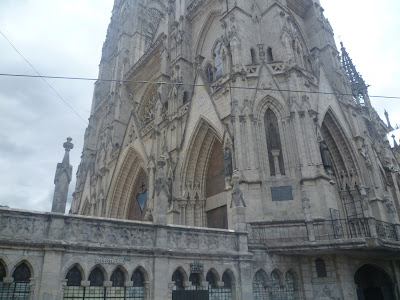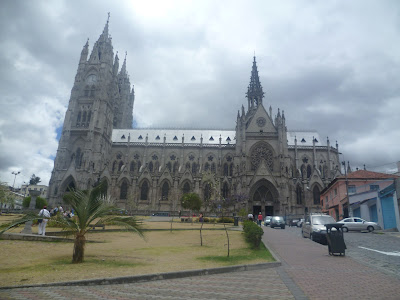Amo la ciudad y quiero compartir lo que es, lo bueno ,malo y bello que da ciudad. Quito como las mejores ciudades para viajar y conocer por ser una de las más conservadas por años. Y si les gustó compartan el blog
Mostrando entradas con la etiqueta San Francisco Museum. Mostrar todas las entradas
Mostrando entradas con la etiqueta San Francisco Museum. Mostrar todas las entradas
jueves, 5 de septiembre de 2013
Arquitectura frontal del Voto Nacional de la Basílica
Etiquetas:
180°,
Alrededores,
arquitectura,
Basílica,
Cielo,
de Latinoamerica,
del,
distintos,
Ecuatoriana,
Iglesia,
Monumento,
Nacional,
Quiteñas,
Quito,
San Francisco Museum,
varios,
viejas,
visitados,
visto,
West
jueves, 15 de agosto de 2013
Casa del Alabado Museo de Arte Precolombino
Casa del Alabado is a private cultural institution
which aims to contribute to the development of culture in Ecuador by
educational ,social ,research ,and conservation. The exhibitions display 500
pieces of the ancient societies that inhabited the Ecuadorian territory in the
past. The museum invites visitors to discover the thought and this Aboriginal
worldview. Casa del Alabado occupies the space of a seventeenth century
colonial house located in the historic center of Quito , between the convents
and plazas of San Francisco and Santa Clara.
domingo, 28 de julio de 2013
Dos Museos Peculiares Franciscanos
Museo Franciscano del Padre Almeida
The Padre Almeida Museum
is located inside San Diego´s monastery of Quito .Here you can find splendid works
of art such as ,the Chiquinquirá Virgin´s Pulpit ,the Crucifix that supports
the legend of “Padre Almeida” and the famous master piece of El Bosco.
The Museum also offers
visits around other locations of the monastery, such as the Sacristy, the
Temple ,the three courtyards , Padre Almeida´s cell, the Bell tower ,The de room and the
Refectory.
El Padre Almeida
Museo está ubicado en el interior del monasterio San Diego de Quito .Aquí puede
encontrar espléndidas obras de arte como "la Virgen de Chiquinquirá Púlpito,
el crucifijo que es compatible con la leyenda de "El Padre Almeida" y
de la famosa obra de El Bosco. Además, el museo ofrece visitas a otros lugares
del monasterio, como la sacristía, el Templo, los tres patios, Padre Almeida la
celda, el campanario, el de habitación y el refectorio.
Museo Fray Pedro
Gocial San Francisco
Built in mud and hay, the first Franciscan church
used to be where the Chapel of the good Venture now stands. The construction of
the main temple and cloister started in 1551 and was finished in 1650.the
actual convent is composed of the Saint Francis church, Cantuña chapel, six
cloisters and the plaza.
Considering its historic and artistic patrimony ,this
is the most import convent in Ecuador. Inside the maximum convent of San Francisco
,we find the ”Fray Pedro Gocial” Museum which exposes the most important
colonial art collection.
Construida en barro y paja, la primera iglesia
de los Franciscanos donde la Capilla de la buena empresa. La construcción del
templo principal y el claustro comenzó en 1551 y se terminó en 1650.el convento
se compone de la iglesia de San Francisco, capilla Cantuña, seis claustros y de
la plaza.
Teniendo en cuenta
su patrimonio histórico y artístico ,este es el más importante convento en
Ecuador. Dentro del convento máximo de San Francisco ,nos encontramos con el
"Fray Pedro Gocial", que expone el museo más importante colección de
arte colonial.
Etiquetas:
Quito,
San Francisco Museum
Ubicación:
Gonzalez Suarez, Quito EC170130, Ecuador
viernes, 5 de julio de 2013
San Francisco Museum
The temple of
San Francisco of Quito is the religious construction of greater extension in
the region. There 4 thousand objects are lodged, between sculptures, linen
cloths and furniture. The most beautiful convent of America. With 3.5 hectares,
San Francisco is an impressive structure. From 1983 the International has been
taken part by the Spanish Agency of Cooperation and the Institute of Cultural
Patrimony. In 1996 a sector of the temple for the San Francisco museum adapted.
And today in this place 250 works are exhibited, of authors like Miguel of
Santiago, Caspicara and Legarda. The museum Fray Pedro Gocial with hundreds of
colonial pieces was inaugurated. There are three allegories that have with
magic to San Francisco, temple founded by Fray Jodoco Ricke on 1535.
One says that there, in pre-Columbian times, a center of commercial interchange between the dominions worked. Also one talks about, from the Colony, that Felipe II of Spain showed itself to the windows of the Dump to see the cupolas of the Quito temple and to comment the face that him was being the work. And, finally, towards 1600 the mythical Cantuña is the center of a architectonic-demonic feat when attributing him to it, popularly, the construction of the vestibule.
The good thing is that until now it lacks a stone, in one of the bajantes of water of the perrons: for that reason its soul not yet has been caught by Satan. But the legend is single one of their wealth. The same construction represents a feat, because the plant of the convent must overcome the pronounced inclination of the skirts of the Pichincha. And already in their interior, the gold of the incario and the talent of craftsmen of the Quito School register the stamp that turns to the place unique.. Near 4 thousand works, between sculptures, linen cloths, painting mural, adorned with caissons and furniture, are distributed by an area of 3.5 hectares, with a central temple, two main chapels, three cloisters, an abbey, an orchard and a nostalgic brewery.
From 1983, the Spanish Agency of Cooperation the International and the Institute of Cultural Patrimony work in the integral recovery of the complex. At the moment a 50 percent with a considered cost of USD 1 200 000 has advanced. At the moment 20 Ecuadorian technicians make workings of restoration and conservation. Thus, thousand objects of art have recovered. 250 of them are exhibited from 1996 in two galleries that adapted for the Museum of San Francisco.
The route begins by the choir of the church, a precious cockpit with capacity for 61 friars, crossed by two organs German and decorated by an exquisite one adorned with caissons of style to mudéjar, compound of 4,600 wood pieces, in whose center there is a peculiar star of eight ends.
From this site it is descended to the rooms of exhibition, where works of Miguel of Santiago (like emblematic "the Immaculate Eucaristía"), Diego de Robles are appraised, the Father Carlos, Manuel Chili "Caspicara", Bernardine of Legarda, Gregorio de Vásquez, Mateo Mejia, engravings German of century XVIII and a map of South America painted in 1775. The end of the visit is towards the North end of the convent, in the old brewery created by the friars in 1566. In his room of welcome there is a tavern and in the later one it is the gallery and the instruments with which the drink was prepared.
One says that there, in pre-Columbian times, a center of commercial interchange between the dominions worked. Also one talks about, from the Colony, that Felipe II of Spain showed itself to the windows of the Dump to see the cupolas of the Quito temple and to comment the face that him was being the work. And, finally, towards 1600 the mythical Cantuña is the center of a architectonic-demonic feat when attributing him to it, popularly, the construction of the vestibule.
The good thing is that until now it lacks a stone, in one of the bajantes of water of the perrons: for that reason its soul not yet has been caught by Satan. But the legend is single one of their wealth. The same construction represents a feat, because the plant of the convent must overcome the pronounced inclination of the skirts of the Pichincha. And already in their interior, the gold of the incario and the talent of craftsmen of the Quito School register the stamp that turns to the place unique.. Near 4 thousand works, between sculptures, linen cloths, painting mural, adorned with caissons and furniture, are distributed by an area of 3.5 hectares, with a central temple, two main chapels, three cloisters, an abbey, an orchard and a nostalgic brewery.
From 1983, the Spanish Agency of Cooperation the International and the Institute of Cultural Patrimony work in the integral recovery of the complex. At the moment a 50 percent with a considered cost of USD 1 200 000 has advanced. At the moment 20 Ecuadorian technicians make workings of restoration and conservation. Thus, thousand objects of art have recovered. 250 of them are exhibited from 1996 in two galleries that adapted for the Museum of San Francisco.
The route begins by the choir of the church, a precious cockpit with capacity for 61 friars, crossed by two organs German and decorated by an exquisite one adorned with caissons of style to mudéjar, compound of 4,600 wood pieces, in whose center there is a peculiar star of eight ends.
From this site it is descended to the rooms of exhibition, where works of Miguel of Santiago (like emblematic "the Immaculate Eucaristía"), Diego de Robles are appraised, the Father Carlos, Manuel Chili "Caspicara", Bernardine of Legarda, Gregorio de Vásquez, Mateo Mejia, engravings German of century XVIII and a map of South America painted in 1775. The end of the visit is towards the North end of the convent, in the old brewery created by the friars in 1566. In his room of welcome there is a tavern and in the later one it is the gallery and the instruments with which the drink was prepared.
Suscribirse a:
Entradas (Atom)





